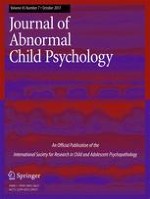05-01-2017
Variation in Response to Evidence-Based Group Preventive Intervention for Disruptive Behavior Problems: A View from 938 Coping Power Sessions
Gepubliceerd in: Research on Child and Adolescent Psychopathology | Uitgave 7/2017
Log in om toegang te krijgenAbstract
Prior research suggests that under some conditions, interventions that aggregate high-risk youth may be less effective, or at worse, iatrogenic. However, group formats have considerable practical utility for delivery of preventive interventions, and thus it is crucial to understand child and therapist factors that predict which aggressive children can profit from group intervention and which do not. To address these questions we video-recorded group Coping Power intervention sessions (938 sessions), coded both leader and participant behavior, and analyzed both leader and children’s behaviors in the sessions that predicted changes in teacher and parent, reports of problem behavior at 1-year follow up. The sample included 180 high-risk children (69% male) who received intervention in 30 separate Coping Power intervention groups (six children assigned per group). The evidence-based Coping Power prevention program consists of 32 sessions delivered during the 4th and 5th grade years; only the child component was used in this study. The behavioral coding system used in the analyses included two clusters of behaviors for children (positive; negative) and two for the primary group leaders (group management; clinical skills). Growth spline models suggest that high levels of children’s negative behaviors predicted increases in teacher and parent rated aggressive and conduct problem behaviors during the follow-up period in the three of the four models. Therapist use of clinical skills (e.g., warmth, nonreactive) predicted less increase in children’s teacher-rated conduct problems. These findings suggest the importance of clinical training in the effective delivery of evidence-based practices, particularly when working with high-risk youth in groups.
